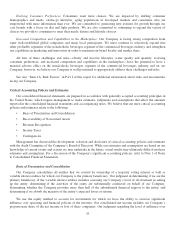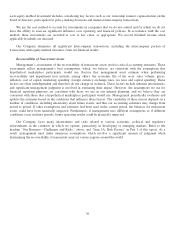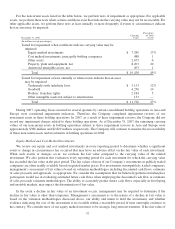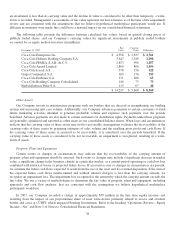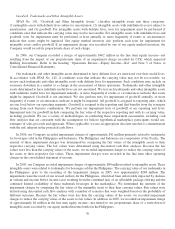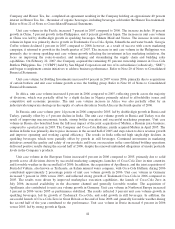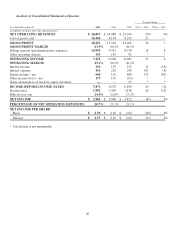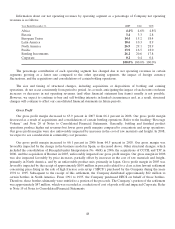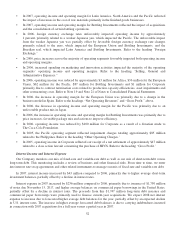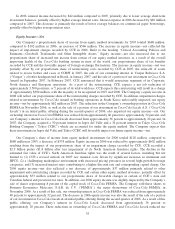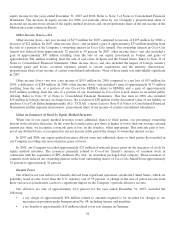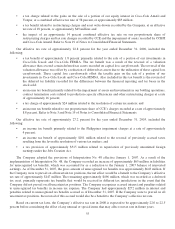Coca Cola 2007 Annual Report Download - page 47
Download and view the complete annual report
Please find page 47 of the 2007 Coca Cola annual report below. You can navigate through the pages in the report by either clicking on the pages listed below, or by using the keyword search tool below to find specific information within the annual report.In Latin America, unit case volume increased 7 percent in 2006 versus 2005, primarily due to growth in sparkling
beverages led by growth of Trademark Coca-Cola. This performance was seen in all key markets, especially Brazil,
Mexico and Argentina. In Mexico, the increase in unit case volume was driven by strong growth in Trademark
Coca-Cola. In Brazil, strong marketing and bottler execution led to unit case volume growth in sparkling beverages. In
Argentina, consumer marketing activities and bottler execution drove unit case volume growth.
Unit case volume in North America was even in 2006 versus 2005. Foodservice and Hospitality unit case volume
increased 1 percent in 2006, reflecting growth in all key beverage categories. Unit case volume in Retail decreased
1 percent primarily driven by weak sparkling beverage trends in the second half of 2006, declines in the
warehouse-delivered water business resulting from the strategic decision to refocus resources behind the more
profitable Dasani business and declines in the warehouse-delivered juice business as a result of price increases to cover
higher ingredient costs. These declines in Retail were partially offset by the continued success of Dasani, Coca-Cola
Zero and Powerade, as well as the introduction of Black Cherry Vanilla Coca-Cola and the national rollout of Vault.
Unit case volume in the Pacific increased 1 percent in 2006 versus 2005, primarily due to double-digit growth in
China, partially offset by a double-digit decline in the Philippines and a 3 percent decline in Japan. The increase in unit
case volume in China was led by significant growth in both sparkling and still beverages. The double-digit decline in
the Philippines was mainly driven by the continued impact of affordability and availability issues. The decrease in unit
case volume in Japan was primarily due to weakness across core brands including Trademark Coca-Cola, Georgia
Coffee and our green tea brands. However, results in Japan gradually improved during 2006.
Unit case volume for Bottling Investments increased 16 percent in 2006 versus 2005, primarily due to the
acquisition of Kerry Beverages Limited, which was subsequently renamed Coca-Cola China Industries Limited
(“CCCIL”), and the acquisitions of TJC Holdings (Pty) Ltd., a South African bottling company (“TJC”), and
Apollinaris. Unit case volume for Bottling Investments also increased due to the consolidation of Brucephil, Inc.
(“Brucephil”), the parent company of The Philadelphia Coca-Cola Bottling Company. In the third quarter of 2006, our
Company signed agreements with J. Bruce Llewellyn and Brucephil for the potential purchase of the remaining shares
of Brucephil not currently owned by the Company. The agreements provide for the Company’s purchase of the shares
upon the election of Mr. Llewellyn or the election of the Company. Based on the terms of these agreements, the
Company concluded that it must consolidate Brucephil under Interpretation No. 46(R). Brucephil’s financial statements
were consolidated effective September 29, 2006. The acquisition of the German bottling company Bremer
Erfrischungsgetraenke GmbH (“Bremer”) during the third quarter of 2005 also contributed to unit case volume
increases in 2006, reflecting the impact of full-year unit case volume in 2006 for Bremer compared to a partial year in
2005. Refer to Note 20 of Notes to Consolidated Financial Statements. The unit case volume increase was partially
offset by a decline in India.
Concentrate Sales Volume
Company-wide concentrate sales volume and unit case volume both grew 6 percent in 2007 when compared to
2006. For 2007, differences between unit case volume and concentrate sales volume growth rates for all segments were
primarily due to timing of concentrate shipments.
Company-wide concentrate sales volume and unit case volume both grew 4 percent in 2006 when compared to
2005. For 2006, differences between unit case volume and concentrate sales volume growth rates for all segments were
primarily due to timing of concentrate shipments. In Eurasia, unit case volume increased ahead of concentrate sales
volume primarily due to inventory reductions in Russia and partially offset by the timing of concentrate sales in India.
Unit case volume growth also reflected the impact of a full-year of unit case volume compared to a partial year in 2005
due to the joint acquisition of Multon with Coca-Cola Hellenic in the second quarter of 2005. The Company only
reports unit case volume related to Multon, as the Company does not sell concentrates or syrups to Multon.
45


